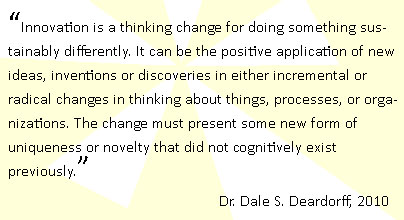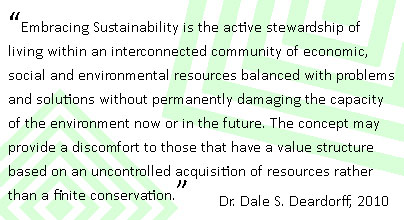|

Creating Organizational Synergies for Working Together by Thinking Together
Current leaders are asking themselves; "How can I help create organizational synergies?” The words seem so easy to say but can be very elusive when it comes to actually seeing it in practice. Just as challenging, is our need to work together to create these proposed synergies. One proposed method to create both of these is to help individuals and organizations ‘think together’.
Some clarification is necessary to establish what we mean by these critical terms. For the purposes of this document, the following operational definitions have been created:
‘Working together’ - Synergy created by teamwork and positive collaboration to accomplish shared goals within cooperative situations.
‘Thinking together’ - A conversation between two or more people increasing thinking skills creating deliberate dialogue for shared meaning and inclusive perceptions.
‘Working together by thinking together’ - Harnessing flexible & diverse mindsets and energies to collaboratively achieve a positive outcome.
Now that we have a cognitive and verbal framework to clearly understand what leaders are searching for, we can help describe the skills, traits and actions necessary for thinking together. When we describe thinking, it is a composite of your personal, traditional (Socratic), vertical (sequential), horizontal (lateral), collaborative (parallel) and synchronized thinking methods. This is a lot to consider when most of us have our thinking on autopilot unless we have a specific agenda or issue which causes us to think harder and sometimes to think smarter. The ultimate goal of thinking together is to create Synergy and help us move forward in a positive direction.
The term synergy comes from the Greek word syn-ergos, which actually means "working together". Synergy is also the process where a combined, cooperative action by independent (separate) parts in a system can result in a greater whole. This can be a challenge for likeminded people but it achieves what I mathematically would model as “1 + 1 = 3”. To illustrate the point further, let’s assume that the output of an individual’s performance or action can lead to a collective positive output. Now let’s describe some additional scenarios:
1 + 1 = 0: The combination of efforts by the individuals is neutral and less than can be achieved individually. Examples of this are when people are not open to listening to others, discard others ideas or refuse to share information they have which could be useful to others.
1 + 1 = -1: The combination of efforts by the individuals is negative and less than could be achieved individually. Examples of this are when people are not working together, fighting or arguing their own agendas.
We have all been in a meeting which seemed to go nowhere because some of the participants ‘agreed to disagree’ and then refused to accept anything that was presented by anyone other than themselves.

Edward de Bono shares a story of a group of fishing boats that hunted conch shells in the Pacific. The boats were not big enough to hold all of the shells and keep them alive as they continued searching for more. If they connected the shells to something, they would drag it away and move to where they could not be found. What the fishermen did was to drill a small hole in the edge of the shell and place a string connecting the shells together with some space. They would then throw 4-5 shells connected together back into the water so they would not die and mark the position. They would come back hours later to retrieve them and find they were in the same position, because the individual conchs were single minded. They worked only to escape in separate directions.
This story clearly illustrates how acting on multiple agendas, by working in different paths, ultimately leads to getting nowhere. We are much smarter than conchs because we have the ability to think together. The ways our brains are wired have evolved beyond this and in the western world we engage in traditional thinking the majority of the time.

Traditional Thinking
Traditional thinking is based upon the ‘Western Thinking’ term invented to describe the philosophical thinking of Western civilization, beginning with the Greek philosophy established by Socrates, Plato, and Aristotle. These three philosophers are also referred to as the “gang of three” and are concerned with ‘What is?’ By this we mean that you engage in inquiry and debate from your point-of view, perceptions and truths. This is concerned with analysis and judgment which constructs our mental models, paradigms, assumptions, and biases.
Socratic thinking is based upon challenging the accuracy and completeness of thinking through argumentation and debate. This can be very limiting in what we are willing to share with others. If the truth is defined by what we can defend logically, then if you can’t see something, it may not be allowed to exist. When we argue our position we set up a defense mechanism to shut down listening to others. The majority of the world’s cultures regard argument as aggressive and limiting. It becomes personal at times and can be non-constructive.
So when we ‘think’ in a traditional mode it seems to have a lot going on at the same time. Our brains are processing input from different sources and filtering what is important now, what we should remember later and pondering if I should try to forget something to make more room. Every day we are bombarded with input from our family, friends, co-workers, strangers, the newspaper, the TV, the internet, and the mailbox every time you open your mail. This input takes the form of debate, negotiation, brainstorming, consensus-building, and dialogue.
No wonder we are exhausted and sometimes make mistakes or omissions in what was said or inferred by others around us. Our Point-of–View can have serious influences on us and how we think. It sets the stage for how we interpret things from others and can be so strong as to lead us to limit what we accept and formulate as the truth. This mental perspective can lead to false viewpoints.
Another perspective of traditional thinking is when we interact as a group trying to create consensus but don’t allow common sense to be expressed. Have you ever thought about speaking up in a meeting but did not because you did not want to appear to be unsupportive of the group’s efforts. If so, you have experienced group-think. This group phenomenon occurs when the desire for group consensus overrides people’s common sense to present alternatives, critique a position or express an unpopular opinion.
As you can see, we use traditional thinking all of the time every day usually with great results. But traditional thinking can have some limitations which prevent synergy. There are four recommended thinking methods that can allow you to separate your thinking at specific times when you need to “Think Together”. These thinking methods are all independent of traditional thinking and can help create synergistic output for different reasons. These are vertical thinking, parallel thinking, lateral thinking, and synchronized thinking.

Vertical Thinking
Vertical thinking is used by academic research teams, musicians, software developers, and people who want to explore a subject deeper not broader. It requires a starting point and only moves if there is a direction to move towards. This thinking is described as analytical and sequential and moves forward one step at a time. Each new step is based upon the previous step it is connected to.
An example would be a situation where you continue to dig a hole, in the same location deeper and deeper. You use information from the past to lead you to new information in the future by selecting a pathway by excluding other pathways. This thinking moves along the widest pathway pointed in the right direction. It is required for logical thinking similar to mathematics. In mathematics there is a mathematical expression or formula that if followed leads to the right answer. The essence of vertical thinking is that you must be “right” at each step as you move forward.
To conduct vertical thinking, you would put together a collection of people who have a set of common skills or expertise in the area you want to conduct the specific thinking. By using this definite approach or technique, you can reach a conclusion through a logical series of steps. It is used to concentrate and exclude what is not relevant and is expected to come up with an “answer” or concept pattern selected from the most promising approach to a problem at this specific time.
- Musical compositions are based upon sequences of notes which are joined together to create patterns. Intermixing these known patterns allows new themes based upon a certain style of music. (country, jazz, pop, rock, hip-hop, classical, techno, thump)
- Academic research is based upon facts and knowledge from specific known areas. Finding more information and facts on a specific subject increases the depth of knowledge and understanding. (taxonomy, classifications, labels, charts, catalogs)
- Software development is based upon code that had been previously written into routines. These routines are connected together to create a sequence or stream that has already been debugged and compiled. (language, program, subroutine, do-loops)
In each of these examples, you can see there is a strong basis of general and specific knowledge in place. This knowledge can be further advanced with vertical thinking by a group of subject matter experts or specialists that think together focused on a logical application of known information.

Horizontal Thinking
Horizontal thinking is solving problems through an indirect and creative approach, using reasoning that is not immediately obvious. This involves new ideas that may not be obtainable by using traditional step-by-step logic. It is also called lateral thinking which moves sideways to another viewpoint looking at different perceptions, concepts and entry points.
An example would be a situation where you stop digging a hole and move to a new location to dig another hole or series of holes. You use new information from anywhere to lead you to new information by selecting a lateral pathway. This thinking involves restructuring, escaping and the provocation of new patterns. The brain is proposed as a self-organizing patterning system which requires jumps to looking at things in a different way that it has been looked at before.
When you’re focused on creating new ideas and concepts, you must break away from old attitudes and approached to restructure new patterns. Three Lateral Thinking tools which can be used to create new ideas are random input, provocation, and challenge idea generation.
- Random input generation - Choose an object at random, or a noun from a dictionary, and associate that with the area you are thinking about. Once you have chosen the word, list its attributions or associations with the word. Then apply each of the items on your list and see how it applies to the problem at hand. Almost any random word will stimulate ideas on the subject.
- Provocation idea generation – choose to use any of the provocation techniques—wishful thinking, exaggeration, reversal, escape, distortion, or arising. With a provocation there is no pretense that the statement will ever be true. It can be manifestly untrue, impossible or contradictory.
- Challenge idea generation - designed to ask the question "Why?" in a non-threatening way: why something exists, why it is done the way it is. The result is a very clear understanding of "Why?" which naturally leads to fresh new ideas. The goal is to be able to challenge anything at all, not just items which are problems.
As you can see, the use of horizontal thinking is concerned with re-arranging and changing patterns to create a new pattern. The juxtaposition of unlikely information is used to think about the future. This type of thinking makes the assumption that the connections for the new ideas are developed from conceptual logic that is ‘wrong’.
A traditional example by Edward de Bono would be a girl who is to be gambled by her father against a heavy debt. If she draws a white pebble from a bag containing one white and one black pebble, the debt is cleared and she will be freed. If, however, the black pebble is drawn out, she must go with the merchant.
The dilemma is that she sees the merchant sneak two black pebbles into the bag, so what should she do? The vertical thinker considers all options and concludes that she should say what she has seen. The lateral thinker, however, thinks beyond this solution that, at best, leaves the girl with a 50% chance of her freedom.
If we think about the pebble that is left behind, which we know is black, all she has to do is pull out one pebble, and while keeping it concealed, clumsily drop it where it cannot be found, then say ‘All we need to do is look at the pebble that is left.’
Horizontal, aka Lateral thinking is thus very much about standing back and looking at the “big picture” and deliberately searching for potentially irrelevant information to allow us to jump to new concepts. It also requires that you focus in on the parts that have perhaps been overlooked, challenging assumptions and seeking alternatives based on how the mind works as a self-organizing pattern making information system.

Collaborative Thinking
Collaborative thinking is a process to reach goals that cannot be achieved acting singly or, at a minimum, cannot be reached as efficiently if we use only a single person. As a thinking process, collaboration is a means to an end, not an end in itself. When we engage in collaborative thinking we are purposely asking other people to become involved in a thinking activity.
Many people thrive working together in teams and accept the concept of collaborative thinking very naturally. They are wired that way. For others, the thought of working together in a team leads them to believe that they will not be as successful as if they were allowed to work independently. This is especially true when it comes to sharing their thinking with others. The natural tendency is for people not to share their thinking because it makes them vulnerable to critique and questioning from others. Many times people feel they may need to justify why they think the way they do so they are limited in what they are willing to share.
Collaborative thinking aka parallel thinking has a specific time and place for its use. When trying to drive a team or group to natural consensus this method will be very powerful. The Six Thinking Hat’s method by Edward de Bono is an example of parallel thinking where a purposeful thinking style is determined and an established period of time is allotted to allow everyone to participate and share in discussion or thinking. A series of six separate metaphorical hats of different colors are used to represent six unique thinking styles. These six distinct thinking states or styles are identified as:
- Information (White) - Considering purely what information is available, what are the facts? Can be used to determine what new information can be required to complete the current thinking.
- Emotions (Red) - Instinctive gut reaction or statements of emotional feeling without requiring any justification.
- Logical Negative judgment (Black) - logic applied to identifying flaws or barriers, seeking mismatch. Any risks or know issues problems or concerns are expressed. The negative attributes about the thing being discussed.
- Logical Positive judgment (Yellow) - logic applied to identifying benefits, seeking harmony. The positive attributes of the thing being discussed.
- Creativity (Green) - Statements of provocation and investigation, seeing where a thought goes. Alternatives and new ideas are constructed.
- Thinking (Blue) - Thinking about the current thinking or managing the thinking that is occurring during the use of the tool. Can be used to establish the thinking agenda for future use in future or continued sessions.
The use of lateral thinking can be increased when you create thinking flows based upon sequencing the thinking modules into a pattern. An example of a thinking pattern might be where you want to do some thinking about buying a new car.
You may start with “White” to get the required information about the make, model and functional characteristics of the car. The second style may be “Yellow” to determine the positive attributes of this particular car. The third style may be the “Black” to determine what negative characteristics are associated with the car. Finally you may use the “Red” to make the decision by evaluating your feelings and intuition about the car and the previous thinking. This sequence can be repeated for a different car and the two can be compared if desired.
Collaborative thinking is about sharing by all participants where they can contribute knowledge, facts, feelings and contradictory views. It allows the users to have multiple truths (pluralism) without feeling like they are being attacked by the thinking styles of others. This dialectic approach to dialogue can help establish multiple points of view about the same subject.

Synchronized Thinking
Synchronous thinking is what can be referred to humorously as “Cosmic Woo-Woo”. This was a term used to describe something you witnessed or experienced that was not explainable with what we knew. We know it when we witness it, and we understand how it happened but repeating it and creating the environment for it is very difficult if not almost impossible. When you, and someone else, look at each other and say the same thing, at the same time, or think the same thing, at the same time - you are then experiencing synchronous thinking.
So first I need to explain that the synchronized thinking we are referring to here is not what is described in the 1999 Cosmic Woo Woo song by Meredith Brooks. It is also not the medical condition where the brain fires or receives simultaneous signals in the right and left hemispheres which has been linked in many publications to schizophrenia and it is finally not the electro-magnetic energy flow associate with ADD and autistic patients.
It is a personal mastery of your thinking where you purposely, while in a group or team think together to achieve a higher goal. Similar to stating “let’s synchronize our watches” you would request that the thinking participants synchronize their thinking. The proverb that “two heads are better than one” illustrates this theory that combined knowledge and thinking effort lead to stronger results. So following that logic, 10 heads would also be better than one, but allot harder to keep everyone focused on the same agenda to get a desired result.
Quickly we can see that just putting 10 people in a room and telling them to all think the same thing is not going to work. What is needed is a process with some structure. By synchronizing their thinking in essence we are asking everyone to operate simultaneously in time or manner. Lucent Technologies has used synchronized team thinking as a business strategy successfully. Despite the complexities related in adopting this strategy, Lucent has employed a cross functional team-based approach that uses the basics of this in their problem-solving process.
The methodology is initiated by defining the problem based on the facts provided by numbers, pictures and experiences. They make ‘all’ of this information available to ‘everyone’ on the team. At any given time each member of the team is working with different experiences and knowledge but they move through the problem-solving process together in a synchronized manner. Then the team determines the root cause of the problem, develops an action plan and countermeasures, and evaluates the whole process by thinking together at the same speed. More non-traditional examples of synchronized thinking are the Hawaiian kahunas and Native American rain dancers.
- Hawaiian Kahunas have historically brought relief to people suffering from many ailments by using non-western thinking. For centuries the Kahunas have understood a unique spiritual and mystical system where information is passed down from one generation to another verbally and through dance. It is proposed that Hawaii is the “chakra” of the world and the “Huna” (secret or hidden) to living a fulfilling life is to awaken your subconscious, conscious and higher self. By mentally directing the flow of energy to heal others the Kahunas engage in synchronous mental, emotional, and physical healing.
- Native American Rain Dancers engage in a practice of synchronized dance, chant and rhythmic drumming to summon rain to come down and nourish the crops. Every August, in late summer when the summer heat bakes much of the Midwest and southern US Native American tribes conduct this collective ritual to bring rain. The steps of the rain dance itself are quite intricate, and unlike circle dances, which are seen in many Native American ceremonies, the men and women stood in separate lines and made zigzagging patterns. It is important that, while many Native American rituals involved only men, the rain dance involved both men and women showing the importance of rain to the entire community.
So you can see there are both traditional and non-traditional synchronized thinking examples that people practice. The basis for the method is to align groups of people by getting them connected to think together in a common cause.

Positive Thinking
Without a doubt one of the hardest thinking modes may be the healthiest for you. When you reflect on your life, is your glass half-empty or half-full? If the thoughts that run through your head are mostly negative, your outlook on life is more likely pessimistic. If your thoughts are mostly positive, you're most likely an optimist who practices positive thinking. Positive thinking is proven to help with stress management and can even improve your overall health, your self image and attitude about the rest of the world. Whether you're an optimistic or pessimistic it's affects your entire life whether you realize it or not. It affects you at work, with your family & friends and the personal reality you create and live in.
Positive thinking also is a key part of effective stress management. Positive thinking doesn't mean that you ignore unpleasant situations that occur; it means that you approach the unpleasantness in a positive and productive way. There are four positive thinking methods that can put positive thinking into action so you can reap the benefits. These are your attitude, self-esteem, and confidence, visualizing success, and creating positive affirmations.
- Attitude - To improve your attitude means to improve your mind. There are many aspects in life that can create a negative impact on the thought process. Change is happening all around us and it can be very uncomfortable. Think about the change from a positive perspective and attitude looking for the positive benefits. A negative attitude can happen within a moment, by getting bad news or by being around negative people can make this change of mind.
- Self Esteem & Confidence - Pay attention to your personal needs and wants. Listen to what your body, your mind, and your heart are telling you. Ignore any and all destructive criticism or insults, including any from your past. Strive to be your best; do not criticize yourself if you fall short of your expectations.
- Visualize Success - Visualization is used by many people in order to achieve goals. The idea is that by visualizing the end result, you become more motivated, and your mind and your body more easily move toward that goal. Remember, you have the choice to lead your life any way you want, not by what others want you to do.
- Positive Affirmations - The purpose of positive affirmations is to clearly describe what changes you want to happen and repeat that statement over and over describing what you want. The most effective affirmations are personal, positive and written in present tense. They can change your attitudes and behaviors and are powerful messages that can positively influence your life.
In one way or another all of us affect the people around us. This happens instinctively and on a subconscious level, through our thoughts, feelings and body language. People sense our aura and are affected by our thoughts, and vice versa. Have you ever walked into a building or met with a team and just felt the negativity. It is apparent in the dialogue, actions, and interactions of these people. It’s no wonder that we want to be around positive people and try avoiding negative ones. People are more likely to help us if we are positive, and they tend to dislike and avoid anyone broadcasting open negativity. Positive thinking is a practice and it requires that you have a certain mental attitude.
There are an infinite number of types of thinking that can be conducted but traditional thinking has been a great baseline for western society. It is used by almost all of us the majority of the time. The only downside has been that it has limitations which can be overcome easily by using the additional thinking methods described. If your engaged in research or trying to go deeper into a subject use vertical thinking. When trying to create new ideas and looking for the non-obvious use horizontal thinking. While working on collective goals and accountability use collaborative thinking. When you find yourself trying to get everyone around you thinking in the same direction, set your thinking into a synchronous mode. And finally, if possible find a way to engage in positive thinking every day. You will see that thinking together with others can be fun and very beneficial to producing individual and organizational ‘synergies’.
Dale S. Deardorff
|










